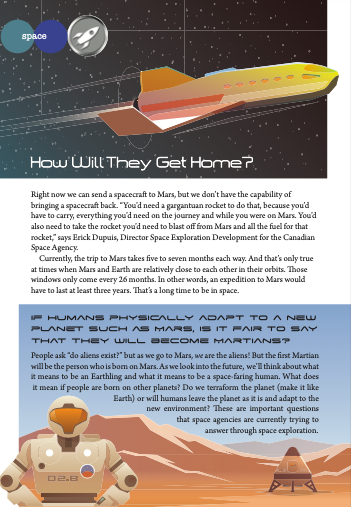
People have been dreaming and writing about going to Mars for hundreds of years. Now it seems like it might come true.
NASA has published Journey to Mars, a plan to send humans to Mars by the 2030s. That’s exciting. However, there are a number of key problems and challenges that have to be dealt with before we can safely send people to Mars. Where will they live? How can we transport everything they will need to live on Mars?



How will they get home?
Right now we can send a spacecraft to Mars, but we don’t have the capability of brining a spacecraft back. “You’d need a gargantuan rocket to do that, because you’d have to carry, everything you’d need on the journey and while you were on Mars. You’d also need to take the rocket you’d need to blast off from Mars and all the fuel for that rocket,” says Erick Dupuis, Director Space Exploration Development for the Canadian Space Agency.
Currently, the trip to Mars takes five to seven months each way. And that’s only true at times when Mars and Earth are relatively close to each other in their orbits. Those windows only come every 26 months. In other words, an expedition to Mars would have to last at least three years. That’s a long time to be in space.
If humans physically adapt to a new planet such as Mars, is it fair to say that they will become Martians?
People ask “do aliens exist?” but as we go to Mars, we are the aliens! But the first Martian will be the person who is born on Mars. As we look into the future, we’ll think about what it means to be an Earthling and what it means to be a space-faring human. What does it mean if people are born on other planets? Do we terraform the planet (make it like Earth) or will humans leave the planet as it is and adapt to the new environment? These are important questions that space agencies are currently trying to answer through space exploration.
Counteracting the prolonged effect of weightlessness on humans
Studies of the astronauts who have lived on the International Space Station (ISS) have shown us some of the effects of long-term weightlessness on human bodies. For one thing, most astronauts who have spent six- month periods living on the ISS lose some of their bone density and muscle mass. That’s because they don’t get enough weight-bearing exercise. Weight-bearing exercises – walking, running, lifting weights – force you to work against gravity and are essential for bone and muscle health. It’s pretty hard to get that kind of exercise in a weightless environment.
“That’s why astronauts run on a special treadmill for at least an hour each day using special equipment,” says Perry Johnson-Green, Senior Program Scientist, Life and Physical Sciences, with the Canadian Space Agency. “The treadmill has a special harness that not only keeps them from floating around, it also exerts a downward pressure that simulates the forces of gravity.”
But even so, research shows that astronauts are not getting enough exercise. For example, Canadian scientist Richard Hughson of the University of Waterloo has shown that when astronauts return after six months at the ISS they are at greater risk for developing Type 2 diabetes. “Fortunately, most of these effects are reversible once astronauts return to earth,” says Johnson-Green.
However, if we’re going to send astronauts on three-year missions to Mars we will have to develop more and better ways of making sure they get enough weight-bearing exercise.
Why Mars?
When scientists are looking for places that humans might be able to live in outer space two important questions are:
• Is it feasible to get there?
• Is this an environment that could support human life?
Most planets in our solar system are too far away, and also far too hot or cold for humans. Mars is a lot colder than Earth, but its climate is the most human- friendly of all the planets in the Solar System.
But here’s the big thing Mars has going for it: water (in the form of ice). Water is essential to support human life. If humans are to live on Mars water would be essential, and not only for drinking. Water could also be split into its two parts – hydrogen and oxygen. Oxygen would be used for breathing and hydrogen could be used to make rocket fuel for the return journey.
Mars Facts
- Average winter temperature on Mars: -63°C.
- In summer, temperatures can reach as high as 20°C on the warmest days.
- Mars’ atmosphere is so thin, that it doesn’t hold heat very well.
- Summer nights on Mars are colder than winter nights on Earth.
